Baker R.C. Flow Measurement Handbook: Industrial Designs, Operating Principles, Performance, and Applications
Подождите немного. Документ загружается.


17.2 INDUSTRIAL DESIGNS 407
17.2.2 MATERIALS
Materials of construction may be: for wetted parts 316L stainless steel, NiSpan-C,
Hastelloy-C22, titanium, and zirconium; for gaskets Viton and Kalrez; and for non-
wetted parts 304 or 316 stainless steel.
Manufacturers have had to address the problem of corrosion fatigue, which is
a particular problem where materials are undergoing cyclic stress and an aggressive
environment. Carpenter (1990) provided a useful introduction to material selection
and gave information about alloy composition and examples of corrosion. It is
necessary, therefore, in the Coriolis flowmeter, which depends on vibration and
is applied to some very aggressive fluids, to take particular care that corrosion
fatigue does not occur and that, if it occurs, the results are contained. This has been
achieved by the following:
• Correct choice of materials. Corrosion resistance of 316L stainless steel is a result
of its ability to form a protective oxide film due, primarily, to the presence of
chromium, nickel, and molybdenum. However, this film can break down in cer-
tain fluids and cause pitting, intergranular corrosion, stress corrosion cracking,
and corrosion fatigue (MicroMotion information). Hastelloy-C22 may provide
resistance to both oxidizing and reducing media and is superior to local attack
due to chloride ions because of the formation of a very stable oxide film that
is little affected by chloride ions. However, there is a need for care in the man-
ufacture of tubes from Hastelloy due to localized diffusion of carbon at grain
boundaries resulting from problems in the drawing and annealing
process.
In ad-
dition, brazing with filler materials may cause intergranular penetration cracking
of the Hastelloy (MicroMotion information). Titanium is used by some manufac-
turers because of its favorable elasticity, low density and compressive strength,
coefficient of thermal expansion, and corrosion and abrasion resistance to many
different aggressive fluids (cf. Wagner 1988 on the problem of intergranular stress
corrosion, pitting, etc.);
• Control of amplitude of vibration to ensure that the stress cycles keep within the
design envelope.
• Containment of the vibrating tube in a pressure vessel so that, in the event of
failure, the process line is intact. 316L stainless steel wetted parts may be standard
(except with chlorides and halogens) on most Coriolis flow sensors. This grade
of stainless provides corrosion resistance with the majority of fluids used in the
process industries.
As described earlier, sensor tubes must be flexible to generate sufficient deflection
and phase shift. Thus, relatively thin-walled tubing
is
required. For example, a typical
25-mm (1-in.) sensor may use 19-mm (f-in.) OD tubing with a nominal wall thick-
ness of 1.65 mm (0.065-in.). Unlike most other system components, there is minimal
corrosion and erosion allowance. Therefore, it is not recommended that users rely
on standard compatibility guides, which often incorporate such allowances.
17.2.3 INSTALLATION CONSTRAINTS
Sensors may, in some cases, have preferred orientations due to the complexity of
the meter pipework. For instance, vertical downward flow may sometimes result in
a partially empty flow tube. For liquid applications, any trapped gases should be
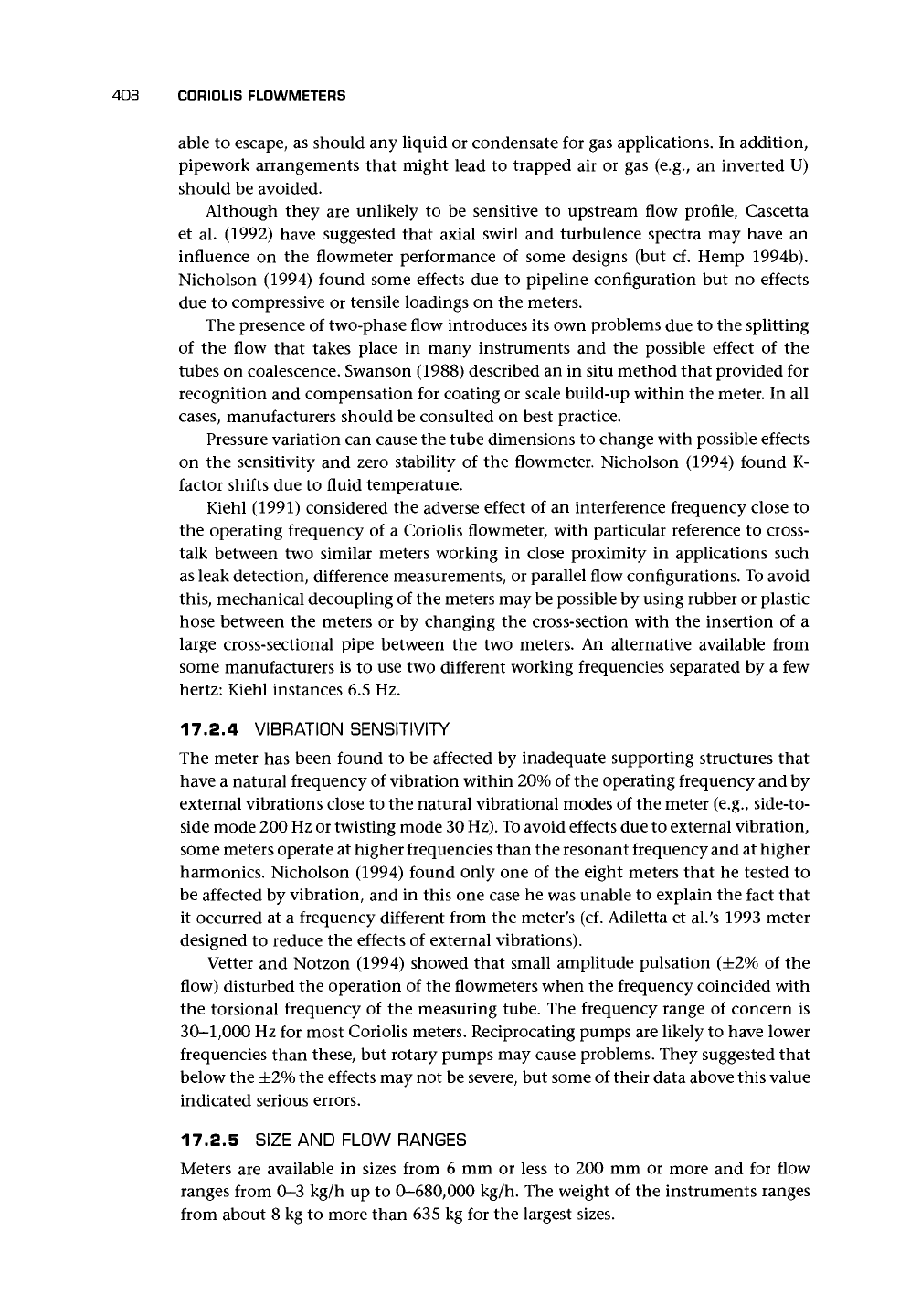
408 C0RI0LIS FLOWMETERS
able to escape, as should any liquid or condensate for gas applications. In addition,
pipework arrangements that might lead to trapped air or gas (e.g., an inverted U)
should be avoided.
Although they are unlikely to be sensitive to upstream flow profile, Cascetta
et al. (1992) have suggested that axial swirl and turbulence spectra may have an
influence on the flowmeter performance of some designs (but cf. Hemp 1994b).
Nicholson (1994) found some effects due to pipeline configuration but no effects
due to compressive or tensile loadings on the meters.
The presence of two-phase flow introduces its own problems due to the splitting
of the flow that takes place in many instruments and the possible effect of the
tubes on coalescence. Swanson (1988) described an in situ method that provided for
recognition and compensation for coating or scale build-up within the meter. In all
cases,
manufacturers should be consulted on best practice.
Pressure variation can cause the tube dimensions to change with possible effects
on the sensitivity and zero stability of the flowmeter. Nicholson (1994) found K-
f act or shifts due to fluid temperature.
Kiehl (1991) considered the adverse effect of an interference frequency close to
the operating frequency of a Coriolis flowmeter, with particular reference to cross-
talk between two similar meters working in close proximity in applications such
as leak detection, difference measurements, or parallel flow configurations. To avoid
this,
mechanical decoupling of the meters may be possible by using rubber or plastic
hose between the meters or by changing the cross-section with the insertion of a
large cross-sectional pipe between the two meters. An alternative available from
some manufacturers is to use two different working frequencies separated by a few
hertz: Kiehl instances 6.5 Hz.
17.2.4 VIBRATION SENSITIVITY
The meter has been found to be affected by inadequate supporting structures that
have a natural frequency of vibration within 20% of the operating frequency and by
external vibrations close to the natural vibrational modes of the meter (e.g., side-to-
side mode 200 Hz or twisting mode 30
Hz).
To avoid effects due to external vibration,
some meters operate at higher frequencies than the resonant frequency and at higher
harmonics. Nicholson (1994) found only one of the eight meters that he tested to
be affected by vibration, and in this one case he was unable to explain the fact that
it occurred at a frequency different from the meter's (cf. Adiletta et al.
;
s 1993 meter
designed to reduce the effects of external vibrations).
Vetter and Notzon (1994) showed that small amplitude pulsation (±2% of the
flow) disturbed the operation of the flowmeters when the frequency coincided with
the torsional frequency of the measuring tube. The frequency range of concern is
30-1,000 Hz for most Coriolis meters. Reciprocating pumps are likely to have lower
frequencies than these, but rotary pumps may cause problems. They suggested that
below the ±2% the effects may not be severe, but some of their data above this value
indicated serious errors.
17.2.5 SIZE AND FLOW RANGES
Meters are available in sizes from 6 mm or less to 200 mm or more and for flow
ranges from 0-3 kg/h up to 0-680,000 kg/h. The weight of the instruments ranges
from about 8 kg to more than 635 kg for the largest sizes.
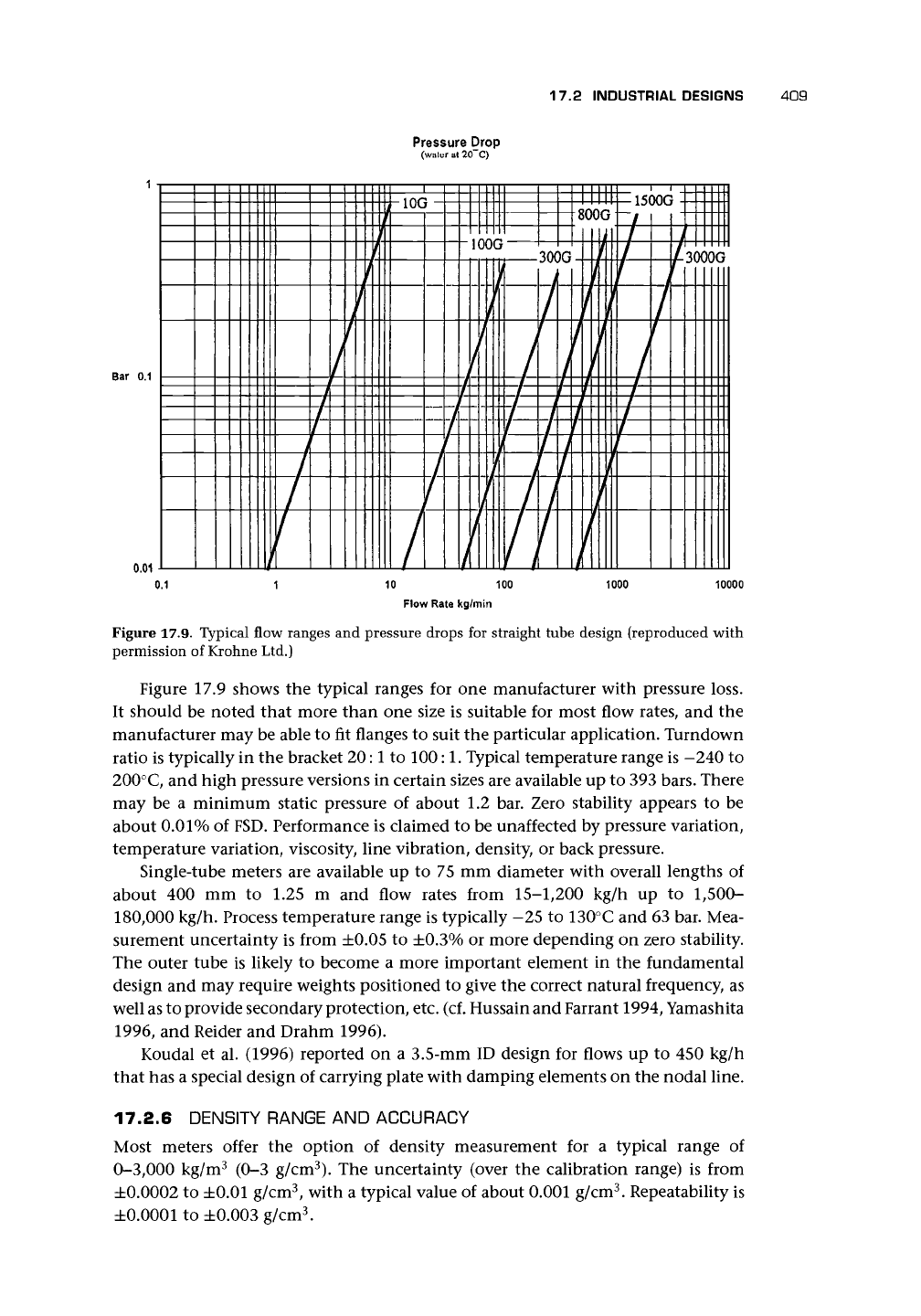
17.2 INDUSTRIAL DESIGNS 409
Pressure Drop
(water ut 20~C)
Bar 0.1
10 100
Flow Rate kg/min
1000
10000
Figure 17.9. Typical flow ranges and pressure drops for straight tube design (reproduced with
permission of Krohne Ltd.)
Figure 17.9 shows the typical ranges for one manufacturer with pressure loss.
It should be noted that more than one size is suitable for most flow rates, and the
manufacturer may be able to fit flanges to suit the particular application. Turndown
ratio is typically in the bracket 20:1 to
100:1.
Typical temperature range is -240 to
200°C, and high pressure versions in certain sizes are available up to 393 bars. There
may be a minimum static pressure of about 1.2 bar. Zero stability appears to be
about 0.01% of
FSD.
Performance is claimed to be unaffected by pressure variation,
temperature variation, viscosity, line vibration, density, or back pressure.
Single-tube meters are available up to 75 mm diameter with overall lengths of
about 400 mm to 1.25 m and flow rates from 15-1,200 kg/h up to
1,500-
180,000 kg/h. Process temperature range is typically -25 to 130°C and 63 bar. Mea-
surement uncertainty is from ±0.05 to ±0.3% or more depending on zero stability.
The outer tube is likely to become a more important element in the fundamental
design and may require weights positioned to give the correct natural frequency, as
well as to provide secondary protection, etc. (cf. Hussain and Farrant 1994, Yamashita
1996,
and Reider and Drahm 1996).
Koudal et al. (1996) reported on a 3.5-mm ID design for flows up to 450 kg/h
that has a special design of carrying plate with damping elements on the nodal line.
17.2.6 DENSITY RANGE AND ACCURACY
Most meters offer the option of density measurement for a typical range of
0-3,000 kg/m
3
(0-3 g/cm
3
). The uncertainty (over the calibration range) is from
±0.0002 to ±0.01 g/cm
3
, with a typical value of about 0.001 g/cm
3
. Repeatability is
±0.0001 to ±0.003 g/cm
3
.
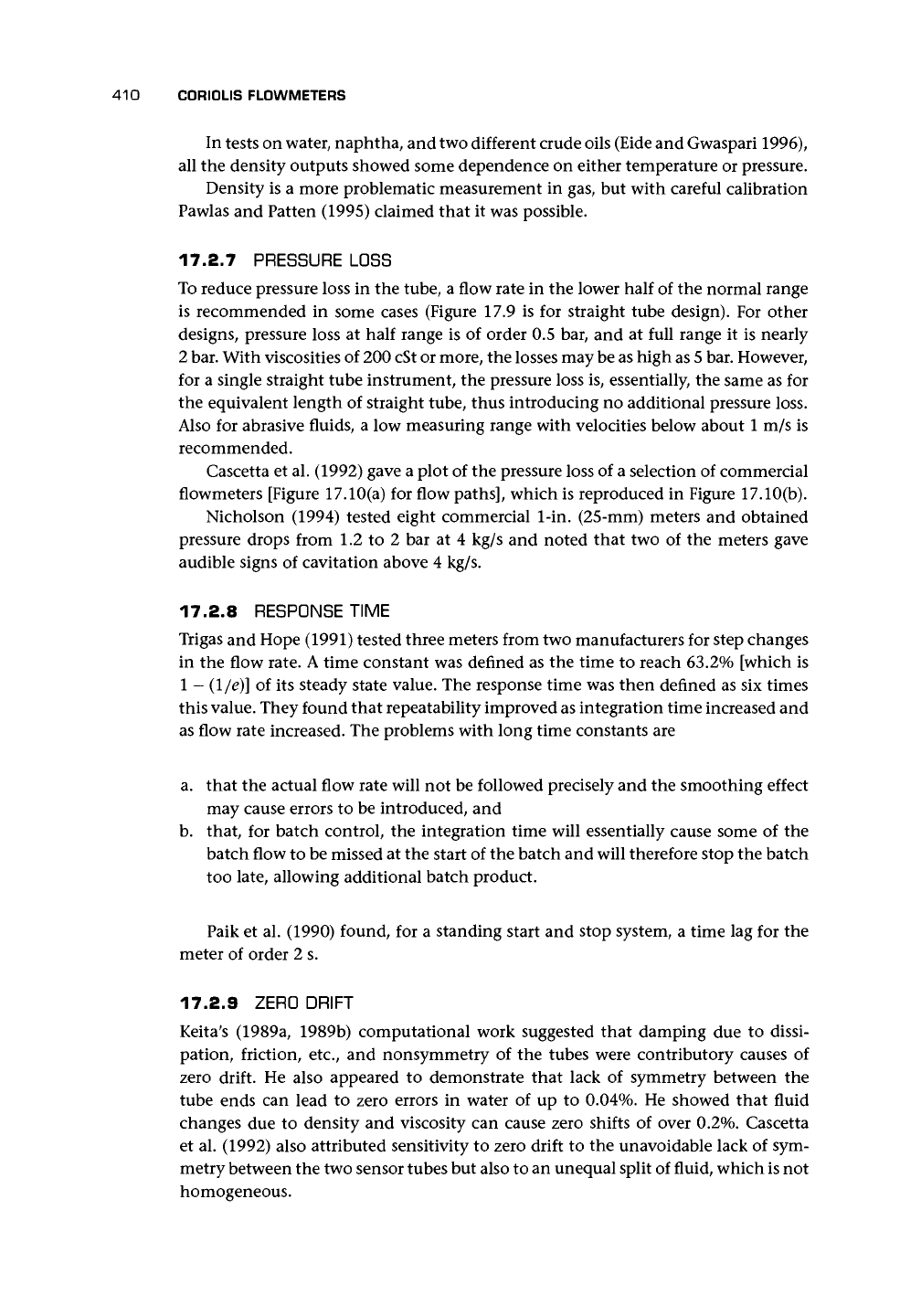
410 C0RI0LIS FLOWMETERS
In tests on water, naphtha, and two different crude oils (Eide and Gwaspari 1996),
all the density outputs showed some dependence on either temperature or pressure.
Density is a more problematic measurement in gas, but with careful calibration
Pawlas and Patten (1995) claimed that it was possible.
17.2.7 PRESSURE LOSS
To reduce pressure loss in the tube, a flow rate in the lower half of the normal range
is recommended in some cases (Figure 17.9 is for straight tube design). For other
designs, pressure loss at half range is of order 0.5 bar, and at full range it is nearly
2 bar. With viscosities of 200 cSt or more, the losses may be as high as 5 bar. However,
for a single straight tube instrument, the pressure loss is, essentially, the same as for
the equivalent length of straight tube, thus introducing no additional pressure loss.
Also for abrasive fluids, a low measuring range with velocities below about 1 m/s is
recommended.
Cascetta et al. (1992) gave a plot of the pressure loss of a selection of commercial
flowmeters [Figure 17.10(a) for flow paths], which is reproduced in Figure 17.10(b).
Nicholson (1994) tested eight commercial 1-in. (25-mm) meters and obtained
pressure drops from 1.2 to 2 bar at 4 kg/s and noted that two of the meters gave
audible signs of cavitation above 4 kg/s.
17.2.8 RESPONSE TIME
Trigas and Hope (1991) tested three meters from two manufacturers for step changes
in the flow rate. A time constant was defined as the time to reach 63.2% [which is
1
—
(l/e)] of its steady state value. The response time was then defined as six times
this value. They found that repeatability improved as integration time increased and
as flow rate increased. The problems with long time constants are
a. that the actual flow rate will not be followed precisely and the smoothing effect
may cause errors to be introduced, and
b.
that, for batch control, the integration time will essentially cause some of the
batch flow to be missed at the start of the batch and will therefore stop the batch
too late, allowing additional batch product.
Paik et al. (1990) found, for a standing start and stop system, a time lag for the
meter of order 2 s.
17.2.9 ZERO DRIFT
Keita's (1989a, 1989b) computational work suggested that damping due to dissi-
pation, friction, etc., and nonsymmetry of the tubes were contributory causes of
zero drift. He also appeared to demonstrate that lack of symmetry between the
tube ends can lead to zero errors in water of up to 0.04%. He showed that fluid
changes due to density and viscosity can cause zero shifts of over 0.2%. Cascetta
et al. (1992) also attributed sensitivity to zero drift to the unavoidable lack of sym-
metry between the two sensor tubes but also to an unequal split of fluid, which is not
homogeneous.
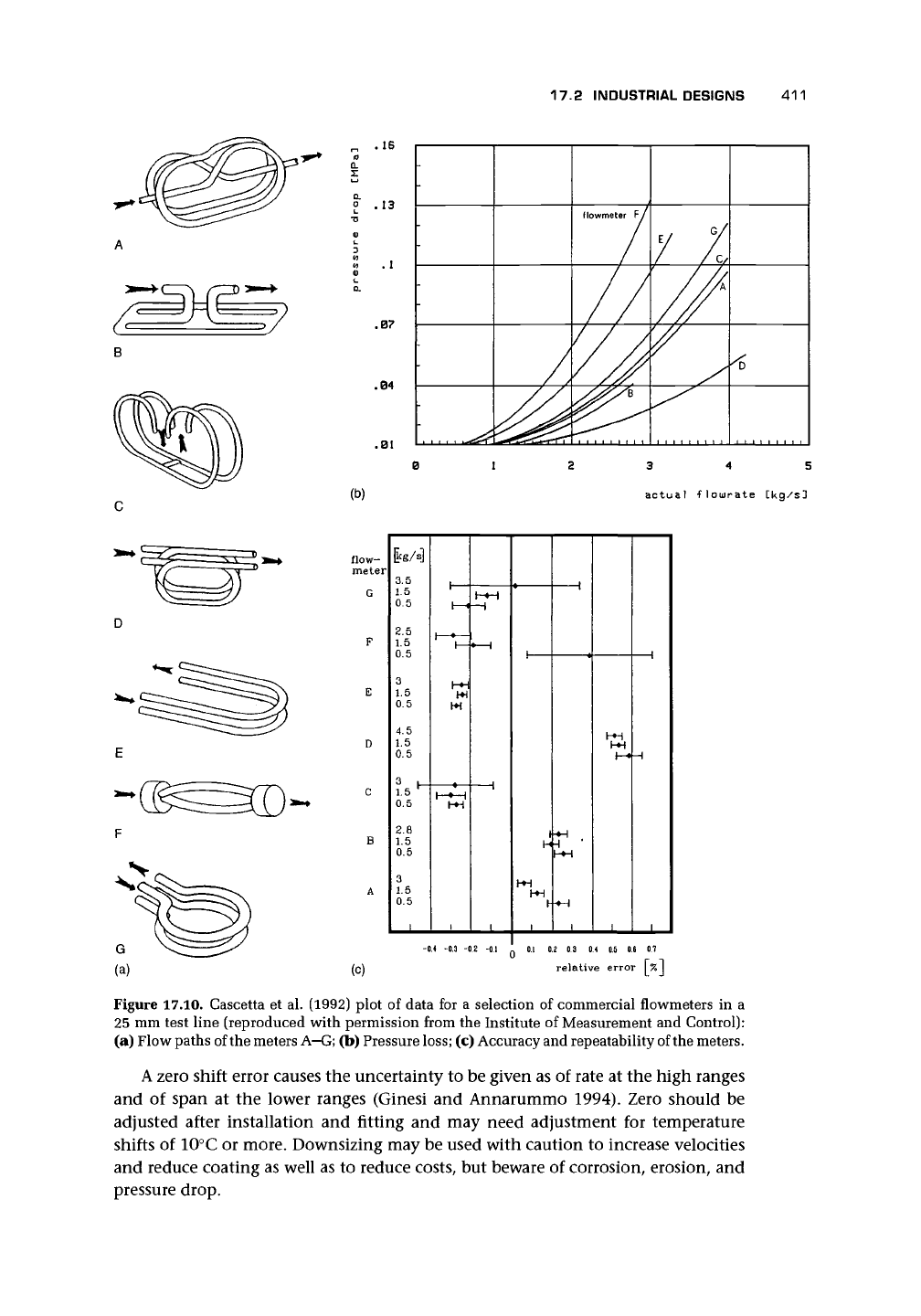
17.2 INDUSTRIAL DESIGNS 411
. 16
. 13
.07
.04
.01
' -**£
/ /
flowmeter F/
//
/ /
'/ /
V
(b)
3 4 5
actual flowrate Ckg/s3
flow-
meter
G
F
E
D
C
B
A
(c)
3.5
1.5
0.5
2.5
1.5
0.5
3
1.5
0.5
4.5
1.5
0.5
3 .
1.5
0.5
2.8
1.5
0.5
3
1.5
0.5
1
i
1 «
1 *
\—
HH
W
W
i ... i
i
—1
«—I
1
-0.4 -0.3 -0.2 -0.1
i
\
H
i
I
H
h-H
I
hH
1—•
1
1
—1
1
j
0.1 0.2 0.3 0.4 0.5 0.6 0.7
relative error [%j
Figure 17.10. Cascetta et al. (1992) plot of data for a selection of commercial flowmeters in a
25 mm test line (reproduced with permission from the Institute of Measurement and Control):
(a) Flow paths of the meters
A—G;
(b) Pressure
loss;
(c) Accuracy and repeatability of the meters.
A zero shift error causes the uncertainty to be given as of rate at the high ranges
and of span at the lower ranges (Ginesi and Annarummo 1994). Zero should be
adjusted after installation and fitting and may need adjustment for temperature
shifts of 10°C or more. Downsizing may be used with caution to increase velocities
and reduce coating as well as to reduce costs, but beware of corrosion, erosion, and
pressure drop.
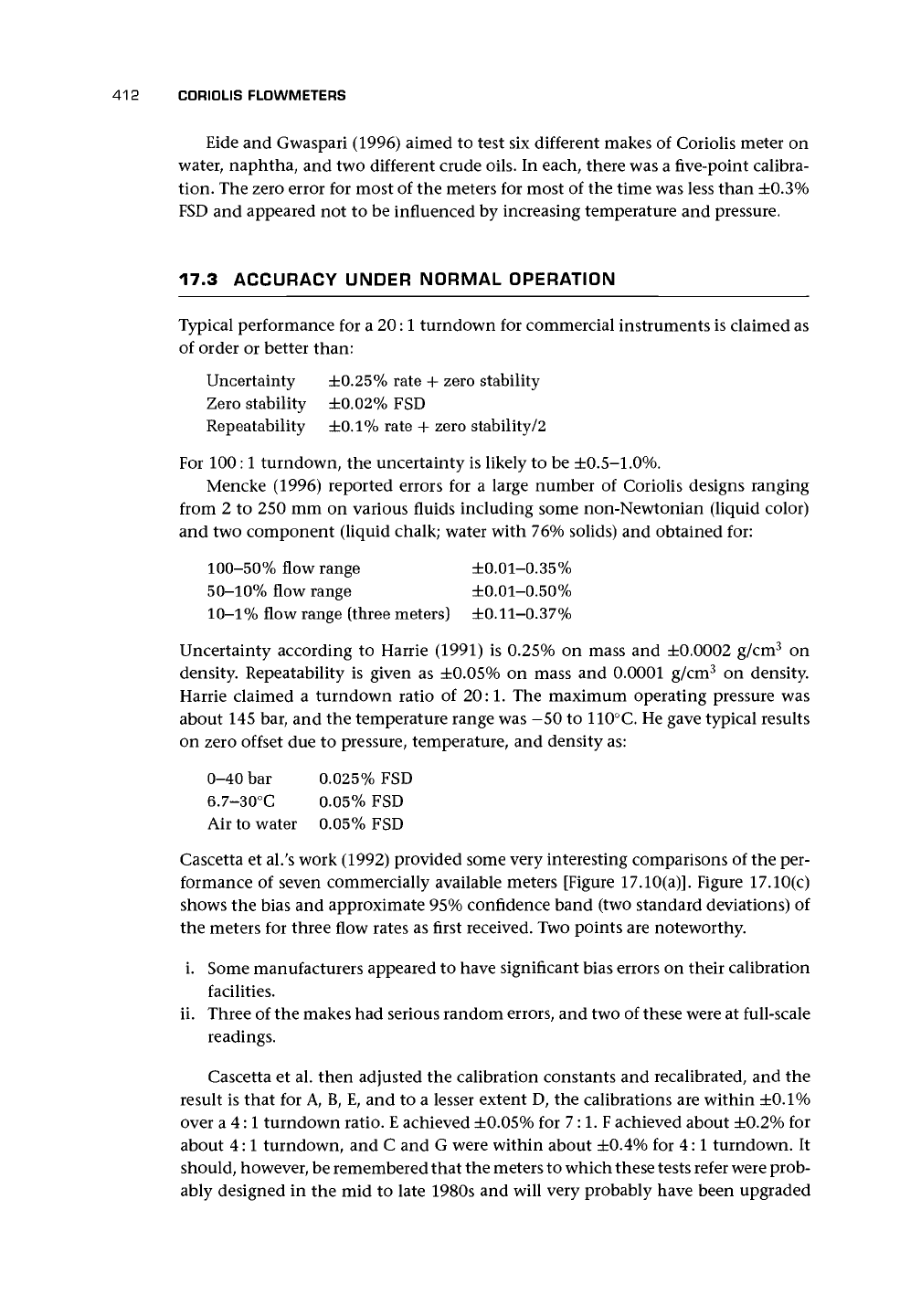
412 CORIOLIS FLOWMETERS
Eide and Gwaspari (1996) aimed to test six different makes of Coriolis meter on
water, naphtha, and two different crude oils. In each, there was a five-point calibra-
tion. The zero error for most of the meters for most of the time was less than ±0.3%
FSD and appeared not to be influenced by increasing temperature and pressure.
17.3 ACCURACY UNDER NORMAL OPERATION
Typical performance for a 20:1 turndown for commercial instruments is claimed as
of order or better than:
Uncertainty ±0.25% rate + zero stability
Zero stability ±0.02% FSD
Repeatability ±0.1% rate + zero stability/2
For 100:1 turndown, the uncertainty is likely to be ±0.5-1.0%.
Mencke (1996) reported errors for a large number of Coriolis designs ranging
from 2 to 250 mm on various fluids including some non-Newtonian (liquid color)
and two component (liquid chalk; water with 76% solids) and obtained for:
100-50% flow range ±0.01-0.35%
50-10%
flow range ±0.01-0.50%
10-1%
flow range (three meters) ±0.11-0.37%
Uncertainty according to Harrie (1991) is 0.25% on mass and ±0.0002 g/cm
3
on
density. Repeatability is given as ±0.05% on mass and 0.0001 g/cm
3
on density.
Harrie claimed a turndown ratio of 20:1. The maximum operating pressure was
about 145 bar, and the temperature range was -50 to 110°C. He gave typical results
on zero offset due to pressure, temperature, and density as:
0-40 bar 0.025% FSD
6.7-30°C 0.05% FSD
Air to water 0.05% FSD
Cascetta et al.'s work (1992) provided some very interesting comparisons of the per-
formance of seven commercially available meters [Figure 17.10(a)]. Figure 17.10(c)
shows the bias and approximate 95% confidence band (two standard deviations) of
the meters for three flow rates as first received. Two points are noteworthy.
i. Some manufacturers appeared to have significant bias errors on their calibration
facilities.
ii.
Three of the makes had serious random errors, and two of these were at full-scale
readings.
Cascetta et al. then adjusted the calibration constants and recalibrated, and the
result is that for A, B, E, and to a lesser extent D, the calibrations are within ±0.1%
over a 4:1 turndown ratio.
E
achieved ±0.05% for 7:1.
F
achieved about ±0.2% for
about 4:1 turndown, and C and G were within about ±0.4% for 4:1 turndown. It
should, however, be remembered that the meters to which these tests refer were prob-
ably designed in the mid to late 1980s and will very probably have been upgraded
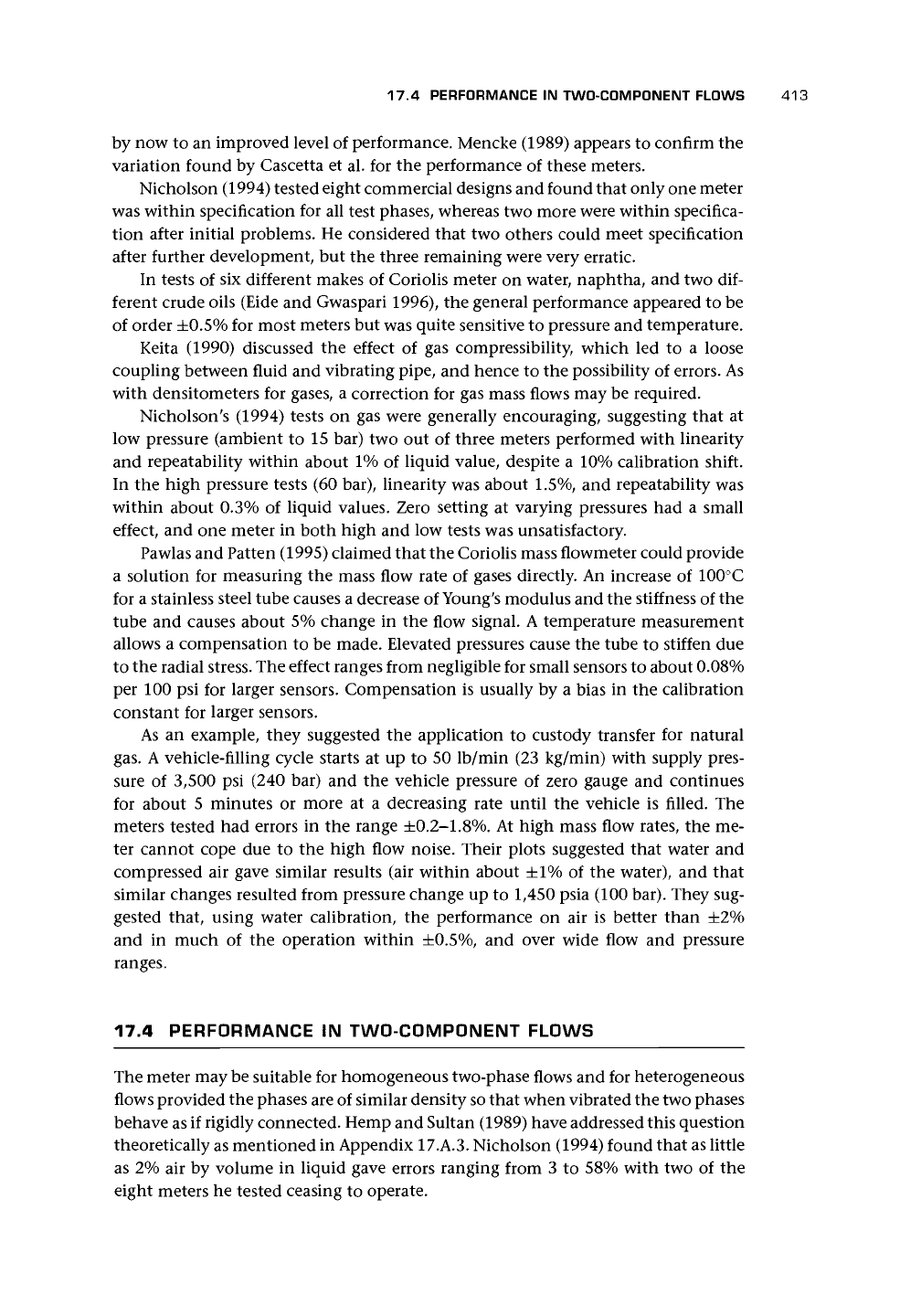
17.4 PERFORMANCE IN TWO-COMPONENT FLOWS 413
by now to an improved level of performance. Mencke (1989) appears to confirm the
variation found by Cascetta et al. for the performance of these meters.
Nicholson (1994) tested eight commercial designs and found that only one meter
was within specification for all test phases, whereas two more were within specifica-
tion after initial problems. He considered that two others could meet specification
after further development, but the three remaining were very erratic.
In tests of six different makes of Coriolis meter on water, naphtha, and two dif-
ferent crude oils (Eide and Gwaspari 1996), the general performance appeared to be
of order ±0.5% for most meters but was quite sensitive to pressure and temperature.
Keita (1990) discussed the effect of gas compressibility, which led to a loose
coupling between fluid and vibrating pipe, and hence to the possibility of errors. As
with densitometers for gases, a correction for gas mass flows may be required.
Nicholson's (1994) tests on gas were generally encouraging, suggesting that at
low pressure (ambient to 15 bar) two out of three meters performed with linearity
and repeatability within about 1% of liquid value, despite a 10% calibration shift.
In the high pressure tests (60 bar), linearity was about 1.5%, and repeatability was
within about 0.3% of liquid values. Zero setting at varying pressures had a small
effect, and one meter in both high and low tests was unsatisfactory.
Pawlas and Patten (1995) claimed that the Coriolis mass flowmeter could provide
a solution for measuring the mass flow rate of gases directly. An increase of 100°C
for a stainless steel tube causes a decrease of Young's modulus and the stiffness of the
tube and causes about 5% change in the flow signal. A temperature measurement
allows a compensation to be made. Elevated pressures cause the tube to stiffen due
to the radial stress. The effect ranges from negligible for small sensors to about 0.08%
per 100 psi for larger sensors. Compensation is usually by a bias in the calibration
constant for larger sensors.
As an example, they suggested the application to custody transfer for natural
gas.
A vehicle-filling cycle starts at up to 50 lb/min (23 kg/min) with supply pres-
sure of 3,500 psi (240 bar) and the vehicle pressure of zero gauge and continues
for about 5 minutes or more at a decreasing rate until the vehicle is filled. The
meters tested had errors in the range ±0.2-1.8%. At high mass flow rates, the me-
ter cannot cope due to the high flow noise. Their plots suggested that water and
compressed air gave similar results (air within about ±1% of the water), and that
similar changes resulted from pressure change up to 1,450 psia (100 bar). They sug-
gested that, using water calibration, the performance on air is better than ±2%
and in much of the operation within
±0.5%,
and over wide flow and pressure
ranges.
17.4 PERFORMANCE IN TWO-COMPONENT FLOWS
The meter may be suitable for homogeneous two-phase flows and for heterogeneous
flows provided the phases are of similar density so that when vibrated the two phases
behave as if rigidly connected. Hemp and Sultan (1989) have addressed this question
theoretically as mentioned in Appendix
17.A.3.
Nicholson (1994) found that as little
as 2% air by volume in liquid gave errors ranging from 3 to 58% with two of the
eight meters he tested ceasing to operate.
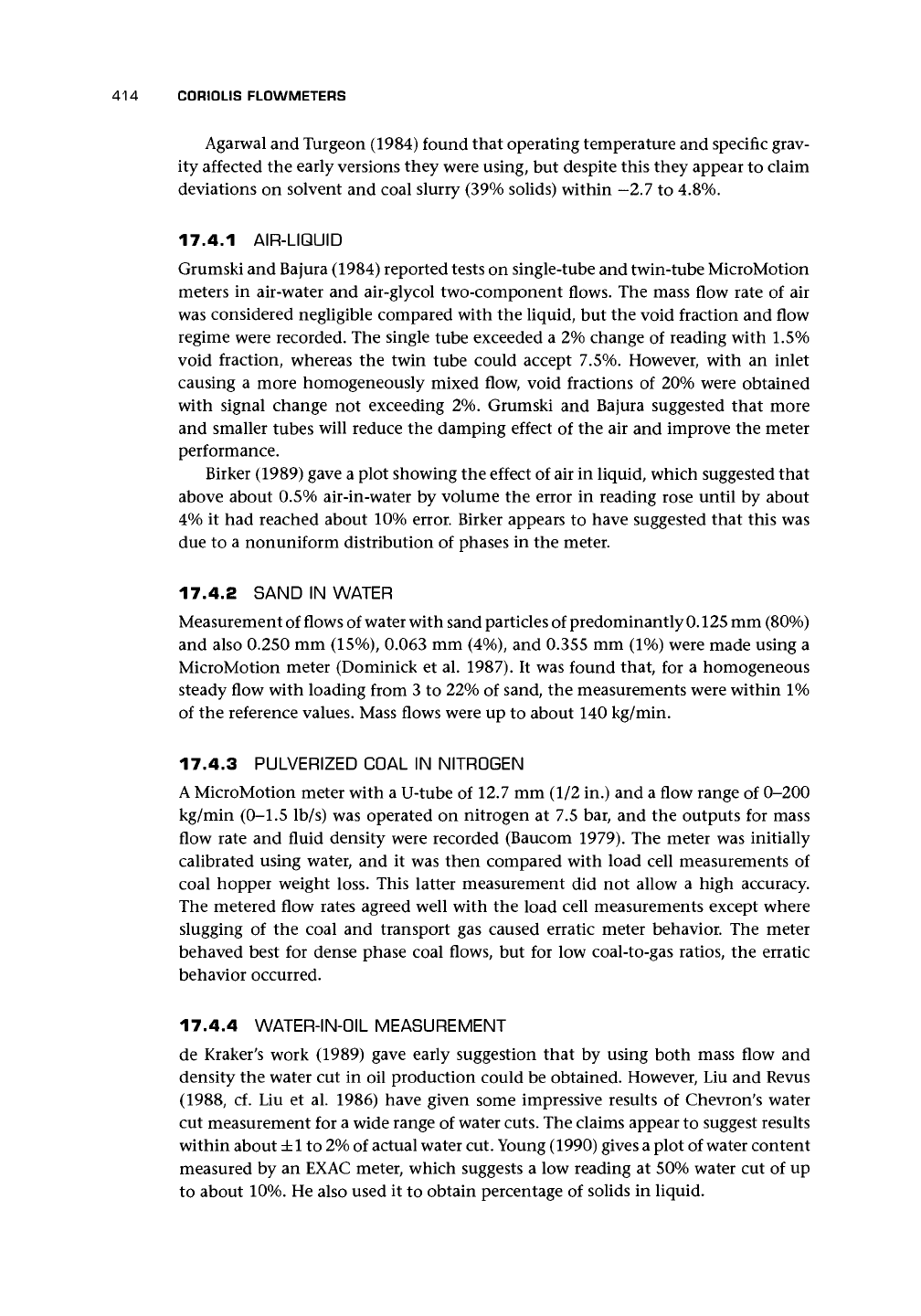
414 CORIOLIS FLOWMETERS
Agarwal and Turgeon (1984) found that operating temperature and specific grav-
ity affected the early versions they were using, but despite this they appear to claim
deviations on solvent and coal slurry (39% solids) within -2.7 to 4.8%.
17.4.1 AIR-LIQUID
Grumski and Bajura (1984) reported tests on single-tube and twin-tube MicroMotion
meters in air-water and air-glycol two-component flows. The mass flow rate of air
was considered negligible compared with the liquid, but the void fraction and flow
regime were recorded. The single tube exceeded a 2% change of reading with 1.5%
void fraction, whereas the twin tube could accept 7.5%. However, with an inlet
causing a more homogeneously mixed flow, void fractions of 20% were obtained
with signal change not exceeding 2%. Grumski and Bajura suggested that more
and smaller tubes will reduce the damping effect of the air and improve the meter
performance.
Birker (1989) gave a plot showing the effect of air in liquid, which suggested that
above about 0.5% air-in-water by volume the error in reading rose until by about
4%
it had reached about 10% error. Birker appears to have suggested that this was
due to a nonuniform distribution of phases in the meter.
17.4.2 SAND IN WATER
Measurement of flows of water with sand particles of predominantly 0.125 mm (80%)
and also 0.250 mm (15%), 0.063 mm (4%), and 0.355 mm (1%) were made using a
MicroMotion meter (Dominick et al. 1987). It was found that, for a homogeneous
steady flow with loading from 3 to 22% of sand, the measurements were within 1%
of the reference values. Mass flows were up to about 140 kg/min.
17.4.3 PULVERIZED COAL IN NITROGEN
A
MicroMotion meter with a U-tube of 12.7 mm (1/2 in.) and a flow range of 0-200
kg/min (0-1.5 lb/s) was operated on nitrogen at 7.5 bar, and the outputs for mass
flow rate and fluid density were recorded (Baucom 1979). The meter was initially
calibrated using water, and it was then compared with load cell measurements of
coal hopper weight loss. This latter measurement did not allow a high accuracy.
The metered flow rates agreed well with the load cell measurements except where
slugging of the coal and transport gas caused erratic meter behavior. The meter
behaved best for dense phase coal flows, but for low coal-to-gas ratios, the erratic
behavior occurred.
17.4.4 WATER-IN-0IL MEASUREMENT
de Kraker's work (1989) gave early suggestion that by using both mass flow and
density the water cut in oil production could be obtained. However, Liu and Revus
(1988,
cf. Liu et al. 1986) have given some impressive results of Chevron's water
cut measurement for a wide range of water cuts. The claims appear to suggest results
within about ±1 to 2% of actual water cut. Young (1990) gives a plot of water content
measured by an EXAC meter, which suggests a low reading at 50% water cut of up
to about 10%. He also used it to obtain percentage of solids in liquid.
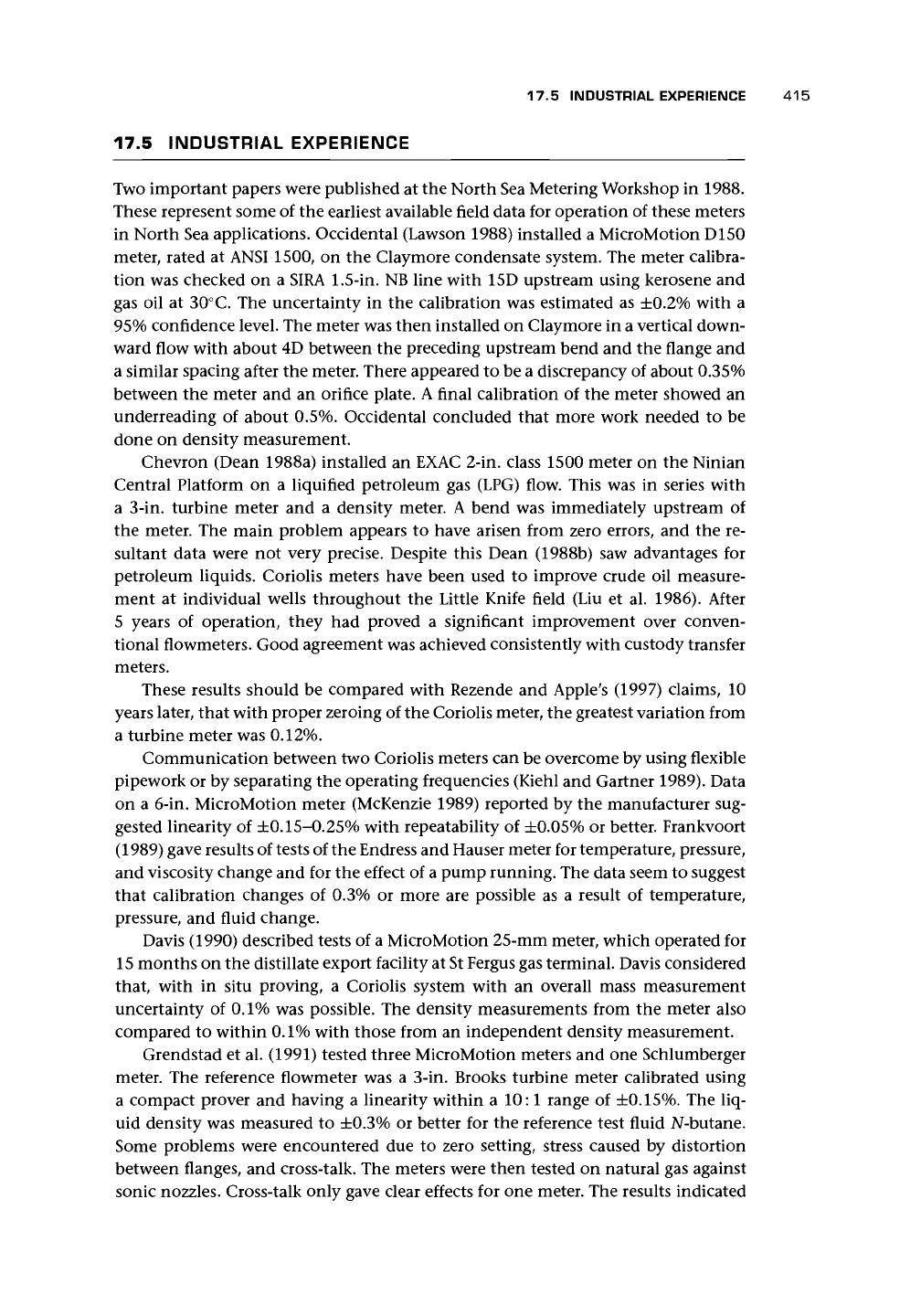
17.5 INDUSTRIAL EXPERIENCE 415
17.5 INDUSTRIAL EXPERIENCE
Two important papers were published at the North Sea Metering Workshop in 1988.
These represent some of the earliest available field data for operation of these meters
in North Sea applications. Occidental (Lawson 1988) installed a MicroMotion D150
meter, rated at ANSI 1500, on the Claymore condensate system. The meter calibra-
tion was checked on a SIRA
1.5-in.
NB line with 15D upstream using kerosene and
gas oil at 30°C. The uncertainty in the calibration was estimated as ±0.2% with a
95%
confidence level. The meter was then installed on Claymore in a vertical down-
ward flow with about 4D between the preceding upstream bend and the flange and
a similar spacing after the meter. There appeared to be a discrepancy of about 0.35%
between the meter and an orifice plate. A final calibration of the meter showed an
underreading of about 0.5%. Occidental concluded that more work needed to be
done on density measurement.
Chevron (Dean 1988a) installed an EXAC 2-in. class 1500 meter on the Ninian
Central Platform on a liquified petroleum gas (LPG) flow. This was in series with
a 3-in. turbine meter and a density meter. A bend was immediately upstream of
the meter. The main problem appears to have arisen from zero errors, and the re-
sultant data were not very precise. Despite this Dean (1988b) saw advantages for
petroleum liquids. Coriolis meters have been used to improve crude oil measure-
ment at individual wells throughout the Little Knife field (Liu et al. 1986). After
5 years of operation, they had proved a significant improvement over conven-
tional flowmeters. Good agreement was achieved consistently with custody transfer
meters.
These results should be compared with Rezende and Apple's (1997) claims, 10
years later, that with proper zeroing of the Coriolis meter, the greatest variation from
a turbine meter was 0.12%.
Communication between two Coriolis meters can be overcome by using flexible
pipework or by separating the operating frequencies (Kiehl and Gartner 1989). Data
on a 6-in. MicroMotion meter (McKenzie 1989) reported by the manufacturer sug-
gested linearity of ±0.15-0.25% with repeatability of ±0.05% or better. Frankvoort
(1989) gave results of tests of the Endress and Hauser meter for temperature, pressure,
and viscosity change and for the effect of a pump running. The data seem to suggest
that calibration changes of 0.3% or more are possible as a result of temperature,
pressure, and fluid change.
Davis (1990) described tests of a MicroMotion 25-mm meter, which operated for
15 months on the distillate export facility at St Fergus gas terminal. Davis considered
that, with in situ proving, a Coriolis system with an overall mass measurement
uncertainty of 0.1% was possible. The density measurements from the meter also
compared to within
0.1%
with those from an independent density measurement.
Grendstad et al. (1991) tested three MicroMotion meters and one Schlumberger
meter. The reference flowmeter was a 3-in. Brooks turbine meter calibrated using
a compact prover and having a linearity within a 10:1 range of ±0.15%. The liq-
uid density was measured to ±0.3% or better for the reference test fluid N-butane.
Some problems were encountered due to zero setting, stress caused by distortion
between flanges, and cross-talk. The meters were then tested on natural gas against
sonic nozzles. Cross-talk only gave clear effects for one meter. The results indicated
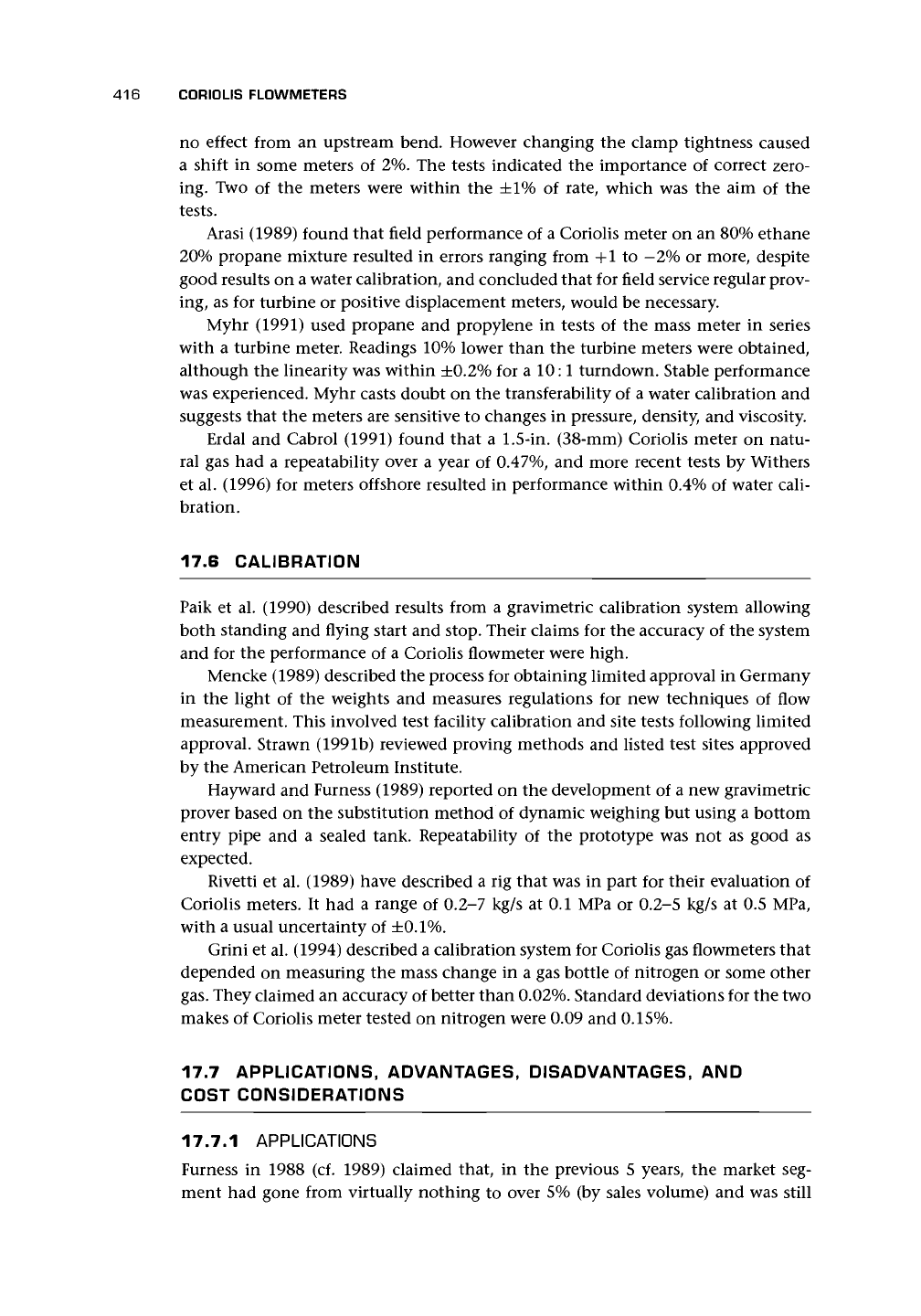
416 CORIOLIS FLOWMETERS
no effect from an upstream bend. However changing the clamp tightness caused
a shift in some meters of 2%. The tests indicated the importance of correct zero-
ing. Two of the meters were within the ±1% of rate, which was the aim of the
tests.
Arasi (1989) found that field performance of a Coriolis meter on an 80% ethane
20%
propane mixture resulted in errors ranging from +1 to
—2%
or more, despite
good results on a water calibration, and concluded that for field service regular prov-
ing, as for turbine or positive displacement meters, would be necessary.
Myhr (1991) used propane and propylene in tests of the mass meter in series
with a turbine meter. Readings 10% lower than the turbine meters were obtained,
although the linearity was within ±0.2% for a 10:1 turndown. Stable performance
was experienced. Myhr casts doubt on the transferability of a water calibration and
suggests that the meters are sensitive to changes in pressure, density, and viscosity.
Erdal and Cabrol (1991) found that a
1.5-in.
(38-mm) Coriolis meter on natu-
ral gas had a repeatability over a year of 0.47%, and more recent tests by Withers
et al. (1996) for meters offshore resulted in performance within 0.4% of water cali-
bration.
17.G CALIBRATION
Paik et al. (1990) described results from a gravimetric calibration system allowing
both standing and flying start and stop. Their claims for the accuracy of the system
and for the performance of a Coriolis flowmeter were high.
Mencke (1989) described the process for obtaining limited approval in Germany
in the light of the weights and measures regulations for new techniques of flow
measurement. This involved test facility calibration and site tests following limited
approval. Strawn (1991b) reviewed proving methods and listed test sites approved
by the American Petroleum Institute.
Hayward and Furness (1989) reported on the development of a new gravimetric
prover based on the substitution method of dynamic weighing but using a bottom
entry pipe and a sealed tank. Repeatability of the prototype was not as good as
expected.
Rivetti et al. (1989) have described a rig that was in part for their evaluation of
Coriolis meters. It had a range of 0.2-7 kg/s at 0.1 MPa or 0.2-5 kg/s at 0.5 MPa,
with a usual uncertainty of
±0.1%.
Grini et al. (1994) described a calibration system for Coriolis gas flowmeters that
depended on measuring the mass change in a gas bottle of nitrogen or some other
gas.
They claimed an accuracy of better than 0.02%. Standard deviations for the two
makes of Coriolis meter tested on nitrogen were 0.09 and 0.15%.
17.7 APPLICATIONS, ADVANTAGES, DISADVANTAGES, AND
COST CONSIDERATIONS
17.7.1 APPLICATIONS
Furness in 1988 (cf. 1989) claimed that, in the previous 5 years, the market seg-
ment had gone from virtually nothing to over 5% (by sales volume) and was still
